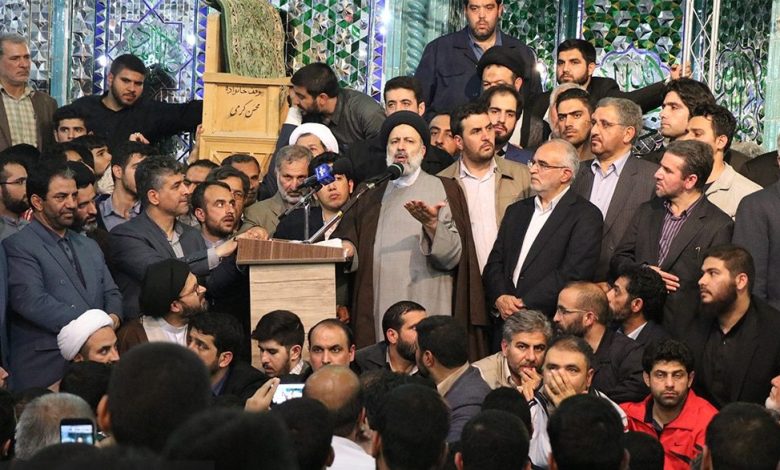Iran’s Ongoing Protests and Raisi’s Economic Surgery

Written by
Sedighe Shahrokhi
Iranian Regime’s president Ebrahim Raisi surrounded by his followers in Kermanshah
Protests in different Iranian cities entered their seventh day on Tuesday. With anti-regime slogans, these demonstrations are the broadest display of a volatile society. But what are the origins of these protests?
Iran has been experiencing various protests and at least eight large-scale uprisings Since 2017. When the November 2019 uprising with over 1500 victims erupted, both the regime and people knew the situation would never be the same.
While viewing the current protests as the result of Iran’s economic crunch would be parochial, ignoring these elements does not allow one to fully appreciate that the country is going through a critical socio-economic transition.
The new series of protests began in Iran following the rapid rise of consumer goods, particularly bread and pasta. While the prices have been experiencing a rising trend in recent years, they skyrocketed soon after Ebrahim Raisi’s government removed the preferential exchange rate.
The preferential rate was the country’s official exchange rate of 42,000 rials to a dollar since 2018, to be ostensibly used to import essential materials such as wheat and medicine. But the regime’s insiders who received the currency imported goods at a lower price but sold them trifold in the market. The prices did not significantly decrease, and since the regime did not have enough currency, it began banknote printing.
The unsupported banknote printing created liquidity much higher than Iran’s low production rate of 3%. Raisi’s government removed the official exchange rate after a lot of fanfare about “combatting corruption.”
Because Iran’s liquidity rate was more than its production and employment rate, inflation has become rampant, causing prices to rise steadily.
Since the regime officials knew removing the official exchange rate could certainly increase prices, they made a lot of flip-flops to implement their so-called “economic operation.”
While many Iranian economists warned that removing the preferential rate would lead to a “currency shock” and will cause prices to jump, Raisi claimed on April 8 that his government “will not create a currency shock by removing the preferential rate.”
But the skyrocketing prices speak for themselves. Since removing the preferential rate, wheat increased by 100% compared to three years ago. The price of flour increased from 25,000 rials to nearly 170,000 rials a kilo, and the cost of medicine has increased tenfold.
“Covert and overt subsidies to the Iranian economy should be eliminated in line with production, investment, and income growth. Production is so dependent on the outside world that tuna fish doubles in price as the dollar exchange rate rises,” the state-run Mostaghel daily wrote on May 10.
So why did Raisi do this?
According to the state-run Eghtesad-e Ayandeh daily on May 14, Raisi’s government would earn roughly $8 billion by removing the preferential rate and setting a much higher currency rate. Iran’s ruling theocracy needs every penny to fuel its warmongering and terrorism machine and use it as leverage in its talks with world powers.
Besides, Raisi’s government earns billions of dollars as the prices of consumer goods continue to increase. “Raisi removes the preferential rate simply because his government wants to benefit from five quadrillion rials [nearly $17 billion] price difference in consumer goods. The claim of spending money for people is a bitter joke,” Mostaghel daily acknowledged on May 10.
According to state-run Jahan-e Sanat, on May 14, in four days, Raisi’s government “took three quadrillion rials from people’s pocket” which caused unprecedented price hikes.
The sudden increase in prices was followed by the recent protests. Raisi’s government promised to give four million rials worth of subsidies to Iranians for two months to calm the society. But as the prices of consumer goods continue to rise, this amount of money would in no way help Iranians make a living.
Besides, even if the regime gave four million rials to Iranians in terms of subsidies, inflation would further increase, leaving Iranians with nothing to acquire their basic needs.
Raisi refuses to say that if the government does not have enough currency, how could he afford to pay the subsidies other than continuing to print banknotes, thus increasing inflation?
“According to the latest monetary statistics of the Central Bank, the volume of liquidity with a growth of 39% at the end of last year has reached 4.8 quadrillion rials. In other words, during the past year, 1.3 quadrillion rials worth of liquidity has been created. The monetary base also grew by 31.4% last year,” the state-run Jahan-e Sanat daily acknowledged on May 10.
“This increase in prices is so great that subsidies will not be able to cover them. People have not used this money, but they see new prices, forcing them to buy chicken, eggs, oil, and dairy at higher prices,” the state-run Jahan-e Sanat daily acknowledged on May 12.
Hossain Raghfar, one of the regime’s economists, called this plan “A new episode of plundering in Iranian economy that government conducts to compensate for the budget deficit.”
Yet, Raisi’s government has so far failed to deceive the public. On May 15, the state-run IMNA news agency quoted Hojjat Abdolmaleki, Raisi’s Minister of Labor, as saying, There have been more than one million cases of protests” in just four days since the so-called “subsidies modification plan was implemented.”
Raisi’s “economic surgery” would “kill Iran’s sick economy,” according to MP Moinoldin Saadi, as quoted by state-run ILNA on May 14.
Raisi is indeed bereft of any solution for Iran’s financial crises. The sole task of the “hanging judge” is to control Iran’s society through oppression and to further squander the national wealth on terrorism, missile, and nuclear projects to preserve the moribund regime. His recent “economic surgery” and increasing oppression attest to this fact.
But the ongoing and expanding protests leave one question: Could these maneuvers save Raisi and the ruling theocracy?

